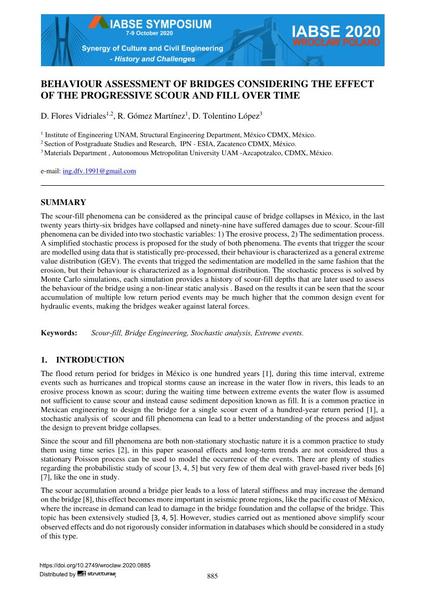Behaviour Assessment of Bridges Considering the Effect of the Progressive Scour and Fill over Time

|
|
|||||||||||
Bibliographic Details
| Author(s): |
D. Flores Vidriales
R. Gómez Martínez D. Tolentino López |
||||
|---|---|---|---|---|---|
| Medium: | conference paper | ||||
| Language(s): | English | ||||
| Conference: | IABSE Symposium: Synergy of Culture and Civil Engineering – History and Challenges, Wrocław, Poland, 7-9 October 2020 | ||||
| Published in: | IABSE Symposium Wroclaw 2020 | ||||
|
|||||
| Page(s): | 885-892 | ||||
| Total no. of pages: | 8 | ||||
| Year: | 2020 | ||||
| DOI: | 10.2749/wroclaw.2020.0885 | ||||
| Abstract: |
The scour-fill phenomena can be considered as the principal cause of bridge collapses in México, in the last twenty years thirty-six bridges have collapsed and ninety-nine have suffered damages due to scour. Scour-fill phenomena can be divided into two stochastic variables: 1) The erosive process, 2) The sedimentation process. A simplified stochastic process is proposed for the study of both phenomena. The events that trigger the scour are modelled using data that is statistically pre-processed, their behaviour is characterized as a general extreme value distribution (GEV). The events that trigged the sedimentation are modelled in the same fashion that the erosion, but their behaviour is characterized as a lognormal distribution. The stochastic process is solved by Monte Carlo simulations, each simulation provides a history of scour-fill depths that are later used to assess the behaviour of the bridge using a non-linear static analysis . Based on the results it can be seen that the scour accumulation of multiple low return period events may be much higher that the common design event for hydraulic events, making the bridges weaker against lateral forces. |
||||
| Keywords: |
extreme events bridge engineering stochastic analysis Scour-fill
|
||||
